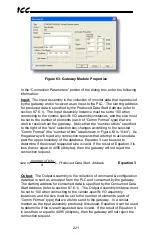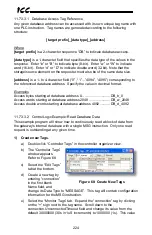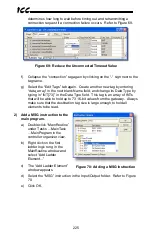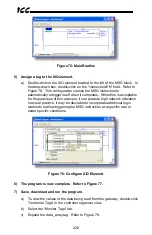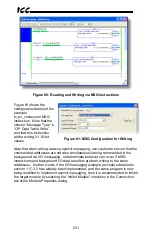
216
ICC
11.7
EtherNet/IP
11.7.1
Overview
The EtherNet/IP protocol is an application-level protocol implemented on top of
the Ethernet TCP/IP and UDP/IP layers. It shares its object model with
ControlNet and DeviceNet through the Common Industrial Protocol (CIP). This
protocol allows the transfer of data and I/O over Ethernet.
EtherNet/IP incorporates both the TCP and UDP layers of Ethernet in the
transmission of data. Because TCP/IP is a point-to-point topology, EtherNet/IP
uses this layer only for explicit messaging; i.e. those messages in which the data
field carries both protocol information and instructions for service performance.
With explicit messaging, nodes must interpret each message, execute the
requested task and generate responses. These types of messages can be used
to transmit configuration, control and monitor data.
The UDP/IP protocol layer, which has the ability to multi-cast, is used for implicit
(I/O) messaging. With I/O messaging, the data field contains only real-time I/O
data; no protocol information is sent because the meaning of the data is pre-
defined at the time the connection is established, which in turn minimizes the
processing time of the node during run-time. I/O messages are short and have
low overhead, which allows for the time-critical performance needed by
controllers.
Some other notes of interest are:
•
The gateway supports the EtherNet/IP protocol (release 1.0), administered
by the Open DeviceNet Vendor Association (ODVA).
•
This product has been self-tested by ICC, Inc. and found to comply with
ODVA EtherNet/IP Conformance Test Software Version A-6.
•
For EtherNet/IP server, the I/O connection sizes for assembly instances 100
and 150 are limited by the gateway only in that they must lie entirely within
the database boundaries.
•
The gateway’s product type code is 12 (Communications Adapter).
•
EtherNet/IP server supports unconnected messages (UCMM), and up to 16
simultaneous class 1 (I/O) or class 3 (explicit) connections.
•
EtherNet/IP client can simultaneously support a class 1 (I/O) and class 3
(explicit) connection per connection object. Each class 3 connection can
support multiple service objects.
•
EtherNet/IP client supports up to 4 connection objects and up to 64 service
objects.
•
EtherNet/IP client class 1 connections currently do not support configuration
data.




















